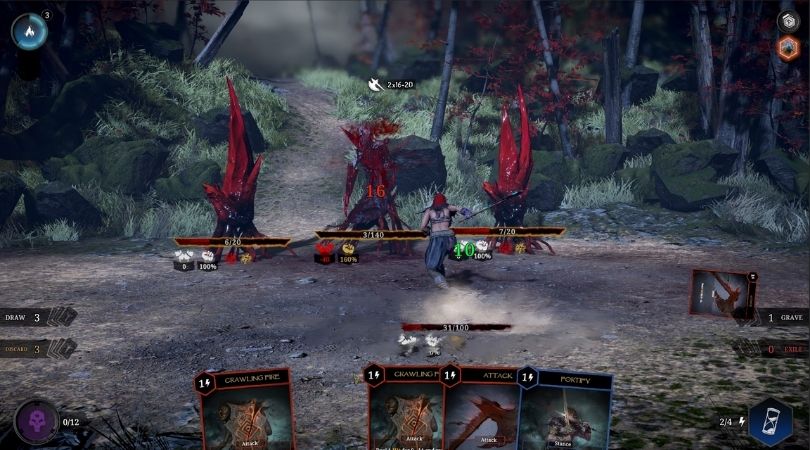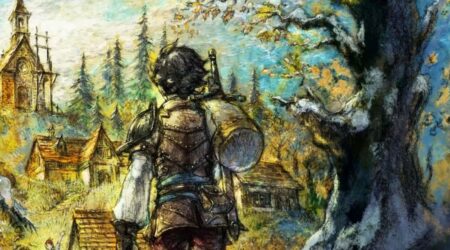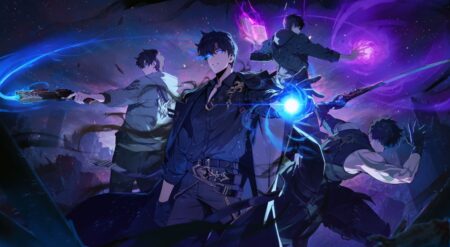Tainted Grail: Conquest is punishingly difficult, but it is also incredibly deep with an intriguing narrative and fantastic design. Developed and published by Polish studio Awaken Realms Digital, Tainted Grail: Conquest is a spin-off of the board game Tainted Grail: Fall of Avalon. The game is a deck-building roguelike RPG that is incredibly deep and slowly builds in complexity and scope over a player’s multiple runs.
The story takes place on the island of Avalon, a hostile wilderness being colonized by humans with a meager survival rate. It begins with the player waking up in an infinite nothingness before a strange goat-like creature approaches them. The player is informed that the world has ended, driven by humanity’s greed. Yet, the player has been spared by Death and suspended in a world where the past and future are jumbled together, giving them an opportunity to figure it all out and stop it from happening. The story is hooking right from the start, even if it is laid out with some heavy exposition.
The player establishes a small village to house other souls that were spared death for some reason. One soul is there at the start of the game with others for the player to find on their adventures. The village is surrounded by a dark magical energy infesting Avalon known as Wyrdness. While it is a bit of an awkward name, the Wyrdness defines much of Tainted Grail’s structure, as players are tasked with venturing out into the Wyrdness to hunt down four different bosses to try and stop what is happening.
This makes up much of Tainted Grail’s core game loop. Players complete runs venturing out of the village, only returning to it upon death or after killing a boss. While out of the village, players fight groups of enemies and interact with points of interest to make decisions, complete quest objectives, and find NPCs to add to their village. The Wyrdness is explored through an isometric perspective, whereas battles are showcased by a closer camera that shows the enemies and player in a small arena to fight. Exploration is also aided by players using consumable Wyrdcandles that help stave off the darkness, but have short wicks.
Tainted Grail: Conquest fights are difficult and high-stakes.
The candles also influence the fights. Fights play out in turns, with the player drawing a hand of cards from their deck and using their 3 energy to play as many cards as they can. Random cards can be added to one’s hand by the Wyrdness that have an effect and another one if the card is not played. If a player has kept their candle well lit, there is a better chance that these cards will be positive, while a lower candle increases the chance that they are punishing.
Fights are difficult and carry high-stakes. One poorly planned or unlucky turn can spell disaster for a run, but they never feel unfair. Every enemy a player faces in a fight displays what they plan to do on their turn. An icon will appear over their head saying whether they plan to heal, attack, debuff, buff, or summon a new monster. The icons even include damage ranges for attacks and healing. In addition, players can hover their mouse over enemies to get a short description of how that enemy type likes to fight.
This puts the onus on countering the enemies and balancing defense and offense on the player. Players can build up blocks, which each negate an enemy attack regardless of its damage numbers, play different buffing or debuffing effects, and perform various attacks. What exactly the player can do depends on the class they chose at the beginning of the run.
Tainted Grail: Conquest is filled with class variety.

There are 9 classes in total, and each one plays completely differently while being very mechanically dense and fleshed out. The sheer amount of variety between the classes is undeniably impressive. Some are simpler, like the pathfinder that builds a damage buff by going consecutive turns without receiving any damage. Others are much more complicated, like the Apostate with double-sided cards that flip every time one is played. Every class feels distinctly unique, with its own personality, card pool, and mechanics built in. Even the three magic classes focused on summoning minions during battle have very different playstyles.
The depth of the mechanics and variety in classes makes Tainted Grail: Conquest never feel unfair. A failed run highlights a player’s mistakes or missteps rather than an unfair attack or overly punishing mechanic. It is truly remarkable how well balanced the classes are despite the sheer variety in what they each offer. As players complete fights, they gain experience and can level up. Every level up lets the player choose from one of three cards to add to their deck, with every few also granting the player a new passive ability that can be incredibly powerful.
Most fights also give players access to a point of interest. Players can find shrines that can offer them healing, wandering merchants with a variety of wares to sell, or NPCs that can be recruited to one’s village. There is a lot of variety in these, but most of them give players a choice. Some are more story-focused, but others are much more mechanically-focused.
Failed runs also keep from feeling too punishing, as the player gains something from every run. Purchased upgrades are kept, newly attained villagers unlock new mechanics and features for players to explore, and the story is slowly dolled out so that players are constantly picking away at it over the course of hours.
Visuals are also another highlight of Tainted Grail: Conquest. Overall the game is incredibly dark and grim, so much so that it may be too much for some players. However, the design elements and excellent music reflect the tone of the setting and story very well. The Wyrdness feels very ominous and claustrophobic, while the enemy designs are grotesque and have a lot of character. The battle animations also look good and add a lot of weight to more powerful cards, while the rotating camera is a good feature that lets players watch the battles from any angle.
Tainted Grail: Conquest is definitely not a title for everyone. Its difficulty and dark atmosphere will undoubtedly be too much for many players out there, even some fans of RPGs, deck-builders, or roguelike. However, for fans that do want those aspects, it’s one of the best in the genre. There are countless hours for players to find in the game, and the deep mechanics and systems are incredibly rewarding across the board.
Tainted Grail: Conquest is available now on PC.
Tainted Grail: Conquest
-
Rating - 9/109/10
TL;DR
Tainted Grail: Conquest is definitely not a title for everyone. Its difficulty and dark atmosphere will undoubtedly be too much for many players out there, even some fans of RPGs, deck-builders, or roguelike. However, for fans that do want those aspects, it’s one of the best in the genre. There are countless hours for players to find in the game, and the deep mechanics and systems are incredibly rewarding across the board.








